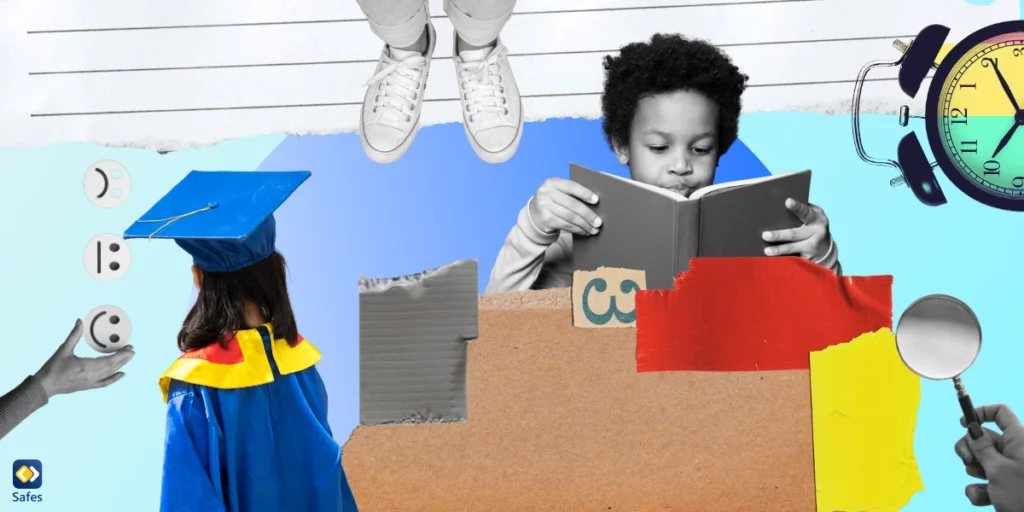We’ve often been asked questions like “My toddler won’t listen to me, what do I do?” As a parent, it can be quite frustrating when your toddler doesn’t listen to you. You may feel like you’re constantly repeating yourself, or that your child is deliberately ignoring you. But the truth is that it’s quite common for toddlers not to listen at times. They’re still learning how to communicate and may not yet have the language skills to articulate their needs and desires. In this blog post, we’ll explore some strategies that parents can use to improve communication and cooperation with their toddlers when they’re not listening. So, if you’ve been wondering why your toddler is not listening, keep reading!
Download and Start Your Free Trial of the Safes Parental Control App
Understanding the Toddler Mindset
Toddlers think and behave very differently from adults, and this can create communication difficulties. For example, toddlers have shorter attention spans and are easily distracted, which can make it challenging for them to focus on what you’re saying. Additionally, they’re still learning how to communicate and may not yet have the language skills to articulate their needs and desires. This can lead to frustration and tantrums.
When a toddler is deliberately not listening, it’s important for parents to adjust their expectations and communication style accordingly. This may involve using shorter, more direct language, or finding ways to make communication more engaging and interactive, such as by using visual aids or incorporating play into learning. By adapting to their toddler’s mindset, parents can help to improve communication and reduce frustration for both themselves and their child.

Reasons Why a Toddler Might Not Listen
There are several common reasons why kids don’t listen, including distractibility, defiance, and developmental differences.
Toddlers are easily distracted, and may not have the attention span to focus on what you’re saying. In this case, parents can try to minimize distractions and use engaging communication techniques, such as using visual aids or incorporating play into learning.
Defiance is another common reason why kids don’t listen. This can manifest as a flat-out refusal to listen or follow directions. In this case, it’s important for parents to set clear expectations and consequences for not following directions, and to be consistent in enforcing them.
Finally, developmental differences can also contribute to communication difficulties. For example, toddlers may not yet have the language skills to fully understand what you’re saying. In this case, parents can adjust their communication style to be more age-appropriate and use repetition and reinforcement to help their children understand.
By understanding the reasons why kids don’t listen and addressing them appropriately, parents can help to improve communication and cooperation with their toddlers.
10 Phrases to Use When Your Toddler Doesn’t Listen
Here are 10 phrases that parents can use when their toddler doesn’t listen, along with a brief explanation of how they can improve communication and cooperation:
- “I need you to look at me when I’m talking to you.” This phrase can help to minimize distractions and ensure that your child is paying attention to what you’re saying.
- “It’s important to listen so we can stay safe.” By emphasizing the importance of listening, you can help your child understand why it’s important to pay attention and follow directions.
- “Can you repeat what I just said?” This phrase can help to ensure that your child has understood what you’re saying, and can also encourage them to engage with you.
- “Let’s take a break and come back to this later.” If your child is feeling overwhelmed or frustrated, taking a break can help to diffuse the situation and make it easier to communicate effectively.
- “I understand that you’re feeling upset, but we need to talk about this.” Acknowledging your child’s feelings can help to build trust and improve communication, while also emphasizing the importance of listening.
- “Can you show me what you mean?” This phrase can be especially helpful for nonverbal children, and can also encourage your child to engage with you and explain their thoughts and feelings.
- “Let’s try this together.” By working together with your child, you can help to build a sense of teamwork and cooperation, while also emphasizing the importance of listening and following directions.
- “I appreciate your help.” Encouraging your child and expressing appreciation for their efforts can help to build confidence and improve communication and cooperation.
- “What do you think we should do?” By asking for your child’s input, you can help to build their sense of autonomy and encourage them to engage with you in a meaningful way.
- “I love you, and I’m here to help.” Expressing love and support can help to build a sense of trust and emotional connection, while also emphasizing the importance of communication and cooperation.

Positive Reinforcement and Discipline Techniques
Positive reinforcement and discipline techniques can be highly effective in encouraging toddlers to listen and cooperate.
One effective technique is to use praise to reinforce positive behaviors. For example, when your child does listen and follow directions, you can praise them by saying something like, “Great job following directions! That was really helpful.” This can help build confidence and encourage your child to continue listening and cooperating.
Explaining the natural consequences of actions is a powerful technique in guiding your child towards better behavior. In our comprehensive guide on disciplining a child who won’t listen, we delved deeper into effective strategies and expert insights.
Another technique is to explain to your child the natural consequences of their actions to help them understand the importance of listening. For example, if your child refuses to put away their toys, you can explain that if they don’t put them away, they won’t be able to find them later. This can help to reinforce the importance of listening and following directions.
It’s important to remember that discipline should always be appropriate and respectful. Avoid using physical punishment or shaming techniques, as these can be harmful to your child’s emotional well-being. Instead, focus on consequences that are appropriate and relevant to the behavior in question.
By using positive reinforcement and appropriate discipline techniques, parents can help to encourage listening and cooperation in their toddlers.
How Can Safes Help You if Your Toddler Doesn’t Listen to You
The Safes parental control app can help parents with toddlers who do not listen to them by allowing them to set limits on screen time and restrict access to age-inappropriate apps and sites. The app has features such as real-time location tracking, screen time management, and content filtering. With Safes, parents can set up a virtual perimeter around certain areas like a park or school and receive notifications when their child leaves or enters that area. Additionally, this app can help parents to monitor their child’s online activity, including social media and chat apps, to ensure they are not exposed to inappropriate content or cyberbullying.
Safes is available on both Android and iOS devices. Download Safe today and benefit from a 14-day free trial with premium features. To learn how to use Safes, follow the links below:
- Windows parental controls
- Macbook parental controls
- Parental controls on Android
- iPhone parental controls
Conclusion
In conclusion, it’s not uncommon for parents to feel frustrated when their toddler is not listening. However, by understanding the reasons why this might be happening and adapting their communication style, parents can improve cooperation and build stronger relationships with their children. Using positive reinforcement and appropriate discipline techniques, like praise and explaining the natural consequences of their actions, can also be effective in encouraging listening and cooperation. Additionally, parental control apps like Safes can help parents set limits on screen time and monitor online activity to ensure their child’s safety. With patience, persistence, and the right strategies, parents can empower their children to become attentive listeners and effective communicators, setting them up for success in all aspects of their lives.
Your Child’s Online Safety Starts Here
Every parent today needs a solution to manage screen time and keep their child safe online.
Without the right tools, digital risks and excessive screen time can impact children's well-being. Safes helps parents set healthy boundaries, monitor activity, and protect kids from online dangers—all with an easy-to-use app.
Take control of your child’s digital world. Learn more about Safes or download the app to start your free trial today!




